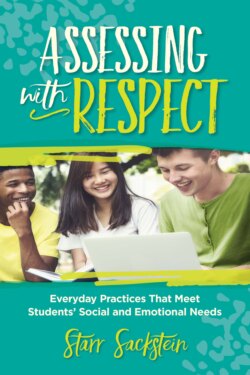Читать книгу Assessing with Respect - Starr Sackstein - Страница 21
На сайте Литреса книга снята с продажи.
Student-Culture Relationships
ОглавлениеIn addition to relationships with one another, students have relationships with the culture that their school cultivates as well as the cultures they come from. To help students understand how their personal cultures enhance the learning environment, have them share information about their backgrounds and then continually nurture an environment that honors the dignity of every member of the classroom—the students and yourself. Developing this cultural depth of knowledge should extend to how you design learning experiences and assessments, including modifying expectations as necessary to account for the needs of all learners.
Taking the time to understand others' values and beliefs contributes to our awareness of and relationship to diversity and helps to build social capital in the classroom. Students will encounter all kinds of people in their lives, and developing curiosity and deepened awareness of other cultures will enhance those relationships and diminish the likelihood of inaccurate assumptions, fears, and prejudices. It is essential to allow students to reflect on their own identities, question their own biases, and work through possible implicit biases that can create unintentional harm. Students of different perspectives, backgrounds, and cultures have something important to share that can't and shouldn't be ignored. Of course, in our efforts to include students, we must be careful to not tokenize those of different backgrounds—that is, use one student as a means for understanding all individuals who have a given background or who identify a certain way (e.g., people of color or members of the LGBTQ community)—which is both inaccurate and dangerous. When we tokenize, we are seeking inclusion but miss the mark because we are more concerned with appearances than actual inclusion.
Allowing time in class to have difficult conversations that address privilege and systemic racism can foster a sense of students and teachers as allies in an effort to ensure that each child feels heard, understood, and welcomed. Of course, I am just scratching the surface here and in no way want to suggest that a few conversations are going to correct such a big problem. Given the complexity of the challenges and prejudices that exist historically, we all must work every day to do better. This is one small way to start.
